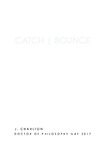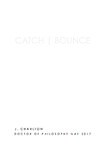CATCH | BOUNCE: Towards a relational ontology of the digital in art practice
| dc.contributor.supervisor | Cox, Geoffrey | |
| dc.contributor.author | Charlton, James | |
| dc.contributor.other | Faculty of Arts, Humanities and Business | en_US |
| dc.date.accessioned | 2017-12-06T12:14:27Z | |
| dc.date.available | 2017-12-06T12:14:27Z | |
| dc.date.issued | 2017 | |
| dc.identifier | 10478970 | en_US |
| dc.identifier.uri | http://hdl.handle.net/10026.1/10377 | |
| dc.description | Full version: Access restricted permanently due to 3rd party copyright restrictions. Restriction set on 06.12.2017 by SE, Doctoral College | |
| dc.description.abstract |
How might ‘the digital’ be conceived of in an ‘expanded field’ of art practice, where ontology is flattened such that it is not defined by a particular media? This text, together with an installation of art work at the Exhibition Research Lab, Liverpool John Moores University (13-24 March), constitutes the thesis submission as a whole, such that in the practice of ‘reading’ the thesis, each element remains differentiated from the other and makes no attempt to ‘represent’ the other. In negating representation, such practices present a ‘radical’ rethinking of the digital as a differentiated in-itself, one that is not defined solely by entrenched computational narratives derived from set theory. Rather, following Nelson Goodman’s nominalistic rejection of class constructs, ‘the digital’ is thus understood in onto-epistemic terms as being syntactically and semantically differentiated (Languages of Art 161). In the context of New Zealand Post-object Art practices of the late 1960s, as read through Jack Burnham’s systems thinking, such a digitally differentiated ontology is conceived of in terms of the how of practice, rather than what of objects (“Systems Aesthetics”). After Heidegger, such a practice is seen as an event of becoming realised by the method of formal indication, such that what is concealed is brought forth as a thing-in-itself (The Event; Phenomenological Interpretations 26). As articulated through the researcher’s own sculptural practice – itself indebted to Post-object Art – indication is developed as an intersubjective method applicable to both artists and audience. However, the constraints imposed on the thing-in-itself by the Husserlian phenomenological tradition are also taken as imposing correlational limitations on the ‘digital’, such that it is inherently an in-itself for-us and thus not differentiated in-itself. To resolve such Kantian dialectics, the thesis draws on metaphysical arguments put forward by contemporary speculative ontologies – in particular the work of Quentin Meillassoux and Tristan Garcia (After Finitude; Form and Object). Where these contemporary continental philosophies provide a means of releasing events from the contingency of human ‘reason’, the thesis argues for a practice of ‘un-reason’ in which indication is recognized as being contingent on speculation. Practice, it is argued, was never reason’s alone to determine. Instead, through the ‘radical’ method of speculative indication, practice is asserted as the event through which the differentiated digital is revealed as a thing-in-itself of itself and not for us. | en_US |
| dc.description.sponsorship | Creative New Zealand | en_US |
| dc.description.sponsorship | Auckland University of Technology | en_US |
| dc.language.iso | en | |
| dc.publisher | University of Plymouth | |
| dc.rights | Attribution-NonCommercial-NoDerivs 3.0 United States | * |
| dc.rights.uri | http://creativecommons.org/licenses/by-nc-nd/3.0/us/ | * |
| dc.subject | Digital Ontology | en_US |
| dc.subject | Digital | en_US |
| dc.subject | New Materialism | en_US |
| dc.subject | Art Practice | en_US |
| dc.subject | Art Research | en_US |
| dc.subject | Speculative Realism | en_US |
| dc.subject | Relational | en_US |
| dc.subject | Post-object Art | en_US |
| dc.subject | Formal indication | en_US |
| dc.subject | Non-correlational | en_US |
| dc.subject | Nelson Godman | en_US |
| dc.subject | Jack Burnham | en_US |
| dc.subject | Speculative indication | en_US |
| dc.subject | Martin Heidegger | en_US |
| dc.subject | Thing-in-itself | en_US |
| dc.subject | Systems-aesthetics | en_US |
| dc.subject | The Event | en_US |
| dc.subject | Practice based research | en_US |
| dc.subject | Onto-epistemology | en_US |
| dc.subject | Sculpture | en_US |
| dc.subject | Installation | en_US |
| dc.subject | Ontology | en_US |
| dc.subject | Flat Ontology | en_US |
| dc.subject.classification | PhD | en_US |
| dc.title | CATCH | BOUNCE: Towards a relational ontology of the digital in art practice | en_US |
| dc.type | Thesis | |
| plymouth.version | non-publishable | en_US |
| dc.identifier.doi | http://dx.doi.org/10.24382/856 | |
| dc.type.qualification | Doctorate | en_US |
| rioxxterms.version | NA | |
| plymouth.orcid.id | orcid.org/0000-0003-2823-9876 | en_US |
Files in this item
This item appears in the following Collection(s)
-
01 Research Theses Main Collection
Research Theses Main




